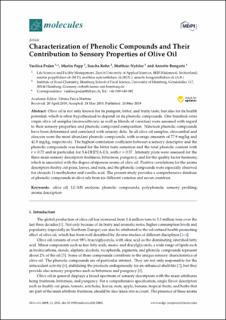Please use this identifier to cite or link to this item:
https://doi.org/10.21256/zhaw-5536| Publication type: | Article in scientific journal |
| Type of review: | Peer review (publication) |
| Title: | Characterization of phenolic compounds and their contribution to sensory properties of olive oil |
| Authors: | Pedan, Vasilisa Popp, Martin Rohn, Sascha Nyfeler, Matthias Bongartz, Annette |
| et. al: | No |
| DOI: | 10.3390/molecules24112041 10.21256/zhaw-5536 |
| Published in: | Molecules |
| Volume(Issue): | 24 |
| Issue: | 11 |
| Page(s): | 2041 |
| Issue Date: | 2019 |
| Publisher / Ed. Institution: | MDPI |
| ISSN: | 1420-3049 1433-1373 |
| Language: | English |
| Subjects: | Olive oil; LC-MS analysis; Phenolic compound; Polyphenol; Sensory profiling; Aroma description |
| Subject (DDC): | 664: Food technology |
| Abstract: | Olive oil is not only known for its pungent, bitter, and fruity taste, but also for its health potential, which is often hypothesized to depend on its phenolic compounds. One hundred extra virgin olive oil samples (monocultivaric as well as blends of varieties) were assessed with regard to their sensory properties and phenolic compound composition. Nineteen phenolic compounds have been determined and correlated with sensory data. In all olive oil samples, oleocanthal and oleacein were the most abundant phenolic compounds, with average amounts of 77.9 mg/kg and 41.8 mg/kg, respectively. The highest correlation coefficient between a sensory descriptor and the phenolic compounds was found for the bitter taste sensation and the total phenolic content with r = 0.72 and in particular, for 3,4-DHPEA-EA, with r = 0.57. Intensity plots were assessed for the three main sensory descriptors fruitiness, bitterness, pungency, and for the quality factor harmony, which is associated with the degree of ripeness aroma of olive oil. Positive correlations for the aroma descriptors freshly cut grass, leaves, and nuts, and the phenolic compounds were especially observed for oleoside 11-methylester and vanillic acid. The present study provides a comprehensive database of phenolic compounds in olive oils from six different varieties and seven countries. |
| URI: | https://digitalcollection.zhaw.ch/handle/11475/17504 |
| Fulltext version: | Published version |
| License (according to publishing contract): | CC BY 4.0: Attribution 4.0 International |
| Departement: | Life Sciences and Facility Management |
| Organisational Unit: | Institute of Food and Beverage Innovation (ILGI) Institute of Computational Life Sciences (ICLS) |
| Appears in collections: | Publikationen Life Sciences und Facility Management |
Files in This Item:
| File | Description | Size | Format | |
|---|---|---|---|---|
| 2019_Pedan_Characterization_of_phenolic_compounds.pdf | 2.1 MB | Adobe PDF |  View/Open |
Show full item record
Pedan, V., Popp, M., Rohn, S., Nyfeler, M., & Bongartz, A. (2019). Characterization of phenolic compounds and their contribution to sensory properties of olive oil. Molecules, 24(11), 2041. https://doi.org/10.3390/molecules24112041
Pedan, V. et al. (2019) ‘Characterization of phenolic compounds and their contribution to sensory properties of olive oil’, Molecules, 24(11), p. 2041. Available at: https://doi.org/10.3390/molecules24112041.
V. Pedan, M. Popp, S. Rohn, M. Nyfeler, and A. Bongartz, “Characterization of phenolic compounds and their contribution to sensory properties of olive oil,” Molecules, vol. 24, no. 11, p. 2041, 2019, doi: 10.3390/molecules24112041.
PEDAN, Vasilisa, Martin POPP, Sascha ROHN, Matthias NYFELER und Annette BONGARTZ, 2019. Characterization of phenolic compounds and their contribution to sensory properties of olive oil. Molecules. 2019. Bd. 24, Nr. 11, S. 2041. DOI 10.3390/molecules24112041
Pedan, Vasilisa, Martin Popp, Sascha Rohn, Matthias Nyfeler, and Annette Bongartz. 2019. “Characterization of Phenolic Compounds and Their Contribution to Sensory Properties of Olive Oil.” Molecules 24 (11): 2041. https://doi.org/10.3390/molecules24112041.
Pedan, Vasilisa, et al. “Characterization of Phenolic Compounds and Their Contribution to Sensory Properties of Olive Oil.” Molecules, vol. 24, no. 11, 2019, p. 2041, https://doi.org/10.3390/molecules24112041.
Items in DSpace are protected by copyright, with all rights reserved, unless otherwise indicated.